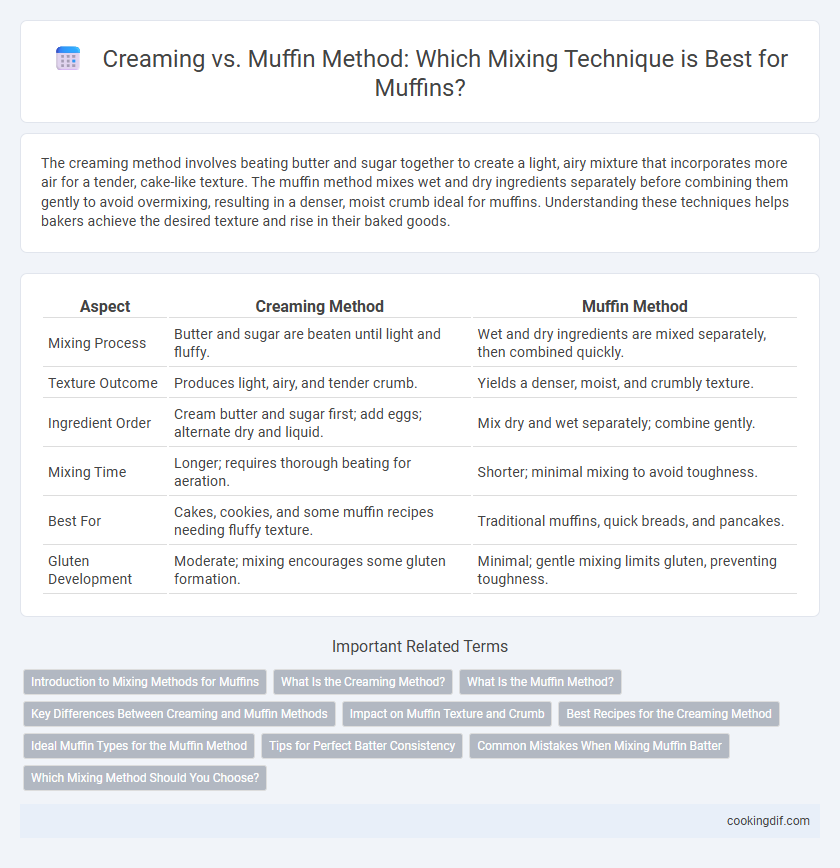The creaming method involves beating butter and sugar together to create a light, airy mixture that incorporates more air for a tender, cake-like texture. The muffin method mixes wet and dry ingredients separately before combining them gently to avoid overmixing, resulting in a denser, moist crumb ideal for muffins. Understanding these techniques helps bakers achieve the desired texture and rise in their baked goods.
Table of Comparison
| Aspect | Creaming Method | Muffin Method |
|---|---|---|
| Mixing Process | Butter and sugar are beaten until light and fluffy. | Wet and dry ingredients are mixed separately, then combined quickly. |
| Texture Outcome | Produces light, airy, and tender crumb. | Yields a denser, moist, and crumbly texture. |
| Ingredient Order | Cream butter and sugar first; add eggs; alternate dry and liquid. | Mix dry and wet separately; combine gently. |
| Mixing Time | Longer; requires thorough beating for aeration. | Shorter; minimal mixing to avoid toughness. |
| Best For | Cakes, cookies, and some muffin recipes needing fluffy texture. | Traditional muffins, quick breads, and pancakes. |
| Gluten Development | Moderate; mixing encourages some gluten formation. | Minimal; gentle mixing limits gluten, preventing toughness. |
Introduction to Mixing Methods for Muffins
Creaming and muffin methods are fundamental techniques for mixing muffin batter, each impacting texture and crumb differently. The creaming method involves beating fat and sugar together to incorporate air, resulting in a lighter, cakier muffin, while the muffin method mixes wet and dry ingredients separately before combining them gently to avoid overdeveloping gluten, producing a denser, tender crumb. Understanding these methods helps bakers control muffin consistency and optimize flavor absorption.
What Is the Creaming Method?
The creaming method involves beating butter and sugar together until light and fluffy, which incorporates air into the batter to create a tender, airy texture in muffins. This technique is essential for recipes requiring a fine crumb and a moist, soft interior. Properly creamed butter and sugar provide structure and enhance leavening, resulting in muffins with a golden crust and uniform rise.
What Is the Muffin Method?
The muffin method involves mixing dry ingredients separately from wet ingredients before combining them briefly to avoid overmixing, resulting in a tender, moist crumb. This technique is commonly used in muffins and quick breads, where a light, airy texture is desired. Unlike the creaming method, which aerates butter and sugar to create a fluffier batter, the muffin method relies on gentle mixing to prevent toughness.
Key Differences Between Creaming and Muffin Methods
The creaming method involves beating butter and sugar together until light and fluffy, incorporating air that promotes a tender, fine crumb texture ideal for cakes and muffins. In contrast, the muffin method mixes wet ingredients separately from dry ingredients, combining them just until moistened to avoid gluten overdevelopment, resulting in a denser, coarser crumb typical of muffins and quick breads. Key differences lie in mixing technique and texture outcome, with creaming producing an aerated, smooth batter and the muffin method yielding a lumpy, thick batter for a hearty, moist final product.
Impact on Muffin Texture and Crumb
The creaming method incorporates air into the batter by beating butter and sugar together, resulting in a lighter, more tender muffin with a fine, even crumb. In contrast, the muffin method mixes wet and dry ingredients until just combined, producing a denser texture with a coarser crumb and a more rustic, hearty bite. Understanding these differences helps bakers control muffin texture and crumb structure to suit specific recipe goals.
Best Recipes for the Creaming Method
The creaming method, essential for classic muffin recipes, involves beating butter and sugar until light and fluffy, creating a tender crumb and enhanced rise. This technique excels in recipes like blueberry muffins and chocolate chip muffins, where a rich, moist texture is desired. Optimizing ingredient temperature and mixing time ensures evenly distributed air pockets, yielding the best muffins with a soft, delicate crumb and consistent bake.
Ideal Muffin Types for the Muffin Method
The muffin method is ideal for producing tender, moist muffins with a slightly coarse crumb, perfect for fruit-filled, bran, and corn muffins. This method involves gently mixing wet and dry ingredients separately before combining them with minimal stirring to avoid gluten overdevelopment. Using the muffin method ensures a soft texture with a lightly domed top, distinguishing it from the denser, finer crumb achieved by the creaming method.
Tips for Perfect Batter Consistency
Achieving perfect batter consistency requires understanding the differences between the creaming and muffin methods. Use the creaming method to beat butter and sugar until light and fluffy, incorporating air for a tender crumb, while the muffin method involves gently mixing wet and dry ingredients just until combined to prevent overdeveloping gluten. Ensure all ingredients are at room temperature and avoid overmixing to maintain the ideal balance of moisture and texture in your muffin batter.
Common Mistakes When Mixing Muffin Batter
Overmixing muffin batter is a common mistake that causes gluten development, resulting in dense and tough muffins rather than light and tender crumb. Using the creaming method instead of the muffin method can lead to uneven texture because the muffin method requires minimal mixing to maintain airiness. Failing to combine wet and dry ingredients gently or overblending after adding flour disrupts the desired moisture balance, negatively affecting rise and crumb structure.
Which Mixing Method Should You Choose?
Choosing between the creaming method and the muffin method depends on the desired texture and batter type. The creaming method, which involves beating butter and sugar until light and fluffy, produces a tender, fine crumb ideal for cupcakes and butter-rich cakes, while the muffin method combines wet and dry ingredients separately with minimal mixing, yielding a denser, coarser texture perfect for quick breads and muffins. Opt for the creaming method when aiming for a delicate crumb and the muffin method for moist, hearty baked goods.
Creaming vs Muffin Method for mixing batter Infographic

 cookingdif.com
cookingdif.com